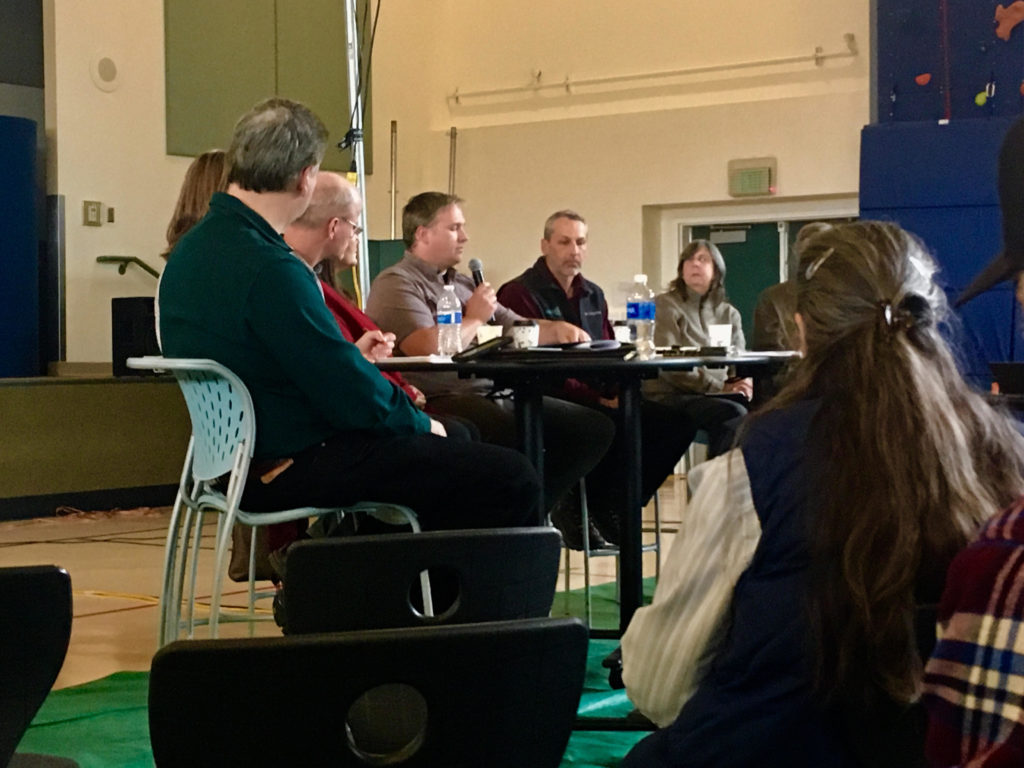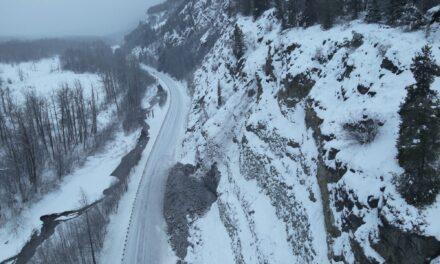
Presenters answered questions as a panel at the end of the mining forum. (Abbey Collins)
A potential hard rock mine has raised a lot of questions for residents of the Chilkat Valley. As mineral exploration continues in the Haines area, the community is learning more about the potential benefits and environmental consequences. A two-day mining forum in Haines addressed some of these issues.
Mineral exploration in Haines’ Upper Valley is known as the Palmer Project. The Canadian company Constantine Metal Resources is trying to determine whether a mine is feasible.
The company says they’ve found promising deposits of minerals containing zinc and copper, as well as some gold and silver.
If a mine went forward, it would likely be a boom for Haines’ economy. But, it would also come with serious environmental risks.
At a recent forum, residents heard from several different voices in the conversation.
Russ White is a local geologist. He explained where Constantine stands in determining the feasibility of a mine. White said right now the company has what are called inferred resources.
“You have a lower confidence that they’re really there,” said White. “You’ve done some drilling; you know there’s mineralization there. But your drill spacing is too wide to be able to say that it’s continuous between your drill holes. That’s the state that they’re at, at Constantine right now.”
Because of that, White said it’s unclear when Constantine will make a decision on whether to go forward with a mine.
Liz Cornejo, with Constantine, described the mineralization the company has found.
“We’ve got areas that are thick, they’re continuous, they’re high-grade,” said Cornejo. “And vertical is a good geometry for mining. So for us it’s worthy of more investigation. And in 2017 we were successful in drilling more of that mineralization. So we’ve been expanding this area off to the west. We also made a discovery out here at a prospect called the Nunatak, we’re calling it the AG Zone. This is another area that may develop into a deposit.”
Cornejo said the deposits that have been discovered are amenable to underground mining methods.
Jacinda Mack is the coordinator of First Nations Women Advocating Responsible Mining, an organization focused on mining reform in British Columbia. Mack’s home and community were directly affected by the Mt. Polley Mine disaster, a tailings spill in 2014.
“We have this real conflicting world views when we’re trying to deal with these operations because what’s good for the mine is not necessarily what’s good for the people, not necessarily what’s good for the land,” said Mack.
Mack said the negative effects of the environmental disaster are lasting, impacting their food sources and nearby water.
The most vocal concern among Haines residents is that the potential Palmer Project mine will cause damage to commercial and subsistence fisheries. The exploration is upstream from the Klehini and Chilkat Rivers. And there’s already local opposition mounting to protect the salmon-bearing waters from potential pollution. The Chilkat Indian Village of Klukwan nominated the Chilkat River for special protection. That application is pending with the state.
So how do you help mitigate environmental concerns, like tailings spills and acid rock drainage? Kendra Zamzow, with the Center for Science in Public Participation, said it’s important to be aware of the risks.
“Accidents happen and human error happens,” said Zamzow. “So a lot of things happen and this is why you need to think ahead, plan ahead and back up your backups.”
She said there are three things that define a high-risk mine.
“The sulfide ore, which you’ve heard some about, and I’ll talk a little more about. The volume of the ore, the more you bring out the more waste there is to manage and it just adds a little more potential for error,” said Zamzow. “And the hydrology is huge. The ability of water to leach contaminants and move contaminants in a wet area, whether it’s a wetland and high precipitation area, is vastly different than if you’re in a dry area.”
With risks and environmental concerns in mind, the development would likely come with economic benefits. Jim Calvin, with the McDowell Group, talked about what an active mine could look like for the Haines economy.
“We don’t have any notion of precisely what the employment footprint might be for a Haines-area mine,” said Calvin. “But again, if we use Greens Creek and Pogo and Kensington as a guide, we can think about 300 jobs. That would be 300 over the course of the year once the mine is up and operating, not thinking about the construction phase. Again with a conservative estimate of what the annual average wage might be for that workforce, that’s about $30 million in annual wages for that workforce.”
Much of the talk at the forum was hypothetical. Constantine is still in the exploration stage. Whether or not the Palmer Project will become a mine and what company would operate it is still unclear. If the project does advance to the mine plan stage, there will be more definitive answers about how environmental risks and other concerns would be addressed.








